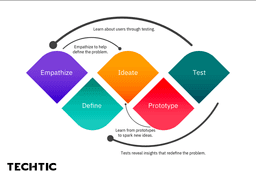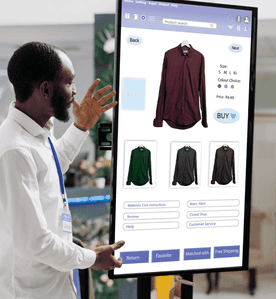Why Design Thinking Should Be Part Of Your Minimum Viable Product
Sector: Digital Product, UI/UX
Author: Nisarg Mehta
Date Published: 09/06/2022

Contents
Uber, Instagram, Airbnb, and even the iPhone were all revolutionary, disruptive, and remarkably effective services and products. However, what they have in common is that they all began as minimum viable products (MVP).
And design thinking has become a popular approach over the last 40 years. It’s utilized in IT, business, education, and even in personal life, among other areas, and is a great approach for building MVPs.
This article will discuss the relationship between design thinking and MVP in detail. So hold yourself together.
First, let’s start with MVP.
What is MVP?
An MVP (minimum viable product) is a test version of a product or service with a minimum set of functions aimed to provide value to the end consumer and gather their feedback. The MVP concept has been around for a while. It was first thought up by Frank Robinson but popularised by Steve Blank, an entrepreneur and academic, and Eric Ries, the founder of the Lean Startup method.
It’s difficult to pinpoint the exact definition of an MVP because it varies from company to company, from industry to industry, from product to product, and from your existing product, and audience groups.
Despite this, the most successful mobile applications on the market began as simplified versions of the mature applications they are today.
Furthermore, an MVP can even be used to upgrade existing applications and improve any digital offering. An MVP provides immediate value, is fast, minimizes development costs, and helps identify the most suitable approach for future development.
Well, that’s the minimum in MVP. But what about “viable”?
Viability is a principle concept of MVP. This means that an MVP should be functional, usable, enjoyable, as well as viable.
A mobile service that clients seek is one that is simple to use and meets their needs. While an MVP is a compact product addressing a tiny portion of client concerns in the context of a broader enterprise strategy, its performance and user experience are still important for gaining and keeping customers.
What is Design Thinking?
Design thinking is an iterative method of problem-solving that helps firms consider business issues in human-centered ways. It prompts businesses to question whether their goals are feasible.
As obvious as it sounds, not every product manager follows this path while building MVPs.
We’ll discuss building MVP using the design thinking approach in the later sections of this article. For now, let’s understand design thinking a bit further.
Design thinking offers a range of strategic advantages and benefits. Its principles are used to generate innovative solutions for evaluating and testing prototypes. It also assists firms in establishing product goals, learning about business outcomes, developing user journeys, determining MVP features’ priority, and creating a future-oriented product roadmap.
Design Thinking Values for MVPs
Design thinking is not a set of steps; it is rather a unique approach to tackling issues. Even if you follow the steps, it is critical to comprehend the principles of design thinking. Here’s how each principle can be utilized in an MVP.
Empathy
Many teams may be experiencing user empathy for the first time when developing an MVP. Design thinking urges product teams to connect with consumers rather than just collect consumer patterns. It’s not just about conducting user interviews—they must have empathy at every stage of the product design process.
Optimism
MVPs are usually built as a testing thing, something that is likely to fail and require redevelopment. Because of this, confidence is crucial: you must remember to proceed with whatever occurs.
Integrative Thinking
With an MVP, product teams attempt to develop a new solution for a problem. Naturally, they must come up with original ideas that have never been done before. Hence, the teams should allow for the most bizarre ideas and attempt brainstorming techniques if they don’t come up with them on their own.
Experimentalism
Some people view the minimum viable product as an experiment, while others disagree. Experimental spirit is crucial for designing a good MVP, regardless of your perspective. Hence, product teams should remember that the competitors’ research is not meant just to copy their methods. They should experiment on their own as well.
Collaboration
Even with just a few developers working on building a minimum viable product, they can become stuck in their own mindsets. It is important to invite people with diverse backgrounds to collaborate, even if there is no budget. Companies may ask their existing customers for assistance or even their suppliers or partners.
If the design thinking principles seem very abstract to you, fret not, they’ll get easier while applying. Hence, let’s discuss how you build an MVP using the design thinking approach.
Building MVP Using Design thinking Approach
The design thinking approach encompasses five stages of MVP development: empathize, define, ideate, prototype, and test. Product teams collaborate with actual customers to create mobile products inspired by how users think, feel, and act in an iterative, flexible framework.

1. Empathize Users
The right UX design makes an indelible impression. Unfortunately, many startups have a hard time developing an MVP that connects with customers. Many products lack purpose, despite being aesthetically pleasing and user-friendly. Hence, it’s crucial to understand what message the product is conveying to its customers. This is the difference between an application that customers keep and one they remove.
Business stakeholders must put themselves in the customers’ shoes to develop a mobile solution that differentiates from the competition as much as possible. Of course, this applies to future applications and existing products as well.
To design for people, you must first develop empathy for them. IDEO studio’s Human-Centered Design Toolkit defines empathy as a deep understanding of the problems and realities of the people you are designing for. This means to better understand people’s digital behavior; you must comprehend their problems and understand their unspoken needs.
You must observe and interact with the people your product is intended for as well as their physical environment, to do this. If you’re upgrading an existing app, you already have a lot of user data. You should reevaluate it now.
2. Define the Problem
In the second step of the design thinking procedure, a relevant and actionable issue statement is created to help set the strategic design direction of the job. All user research outcomes from the empathize phase of the design thinking process are combined to create a problem statement.
The problem definition phase involves collecting and organizing customer research data from the empathize stage to accurately interpret the problems customers face with the product and their emotional responses to the UX design.
Here, the product team should concentrate on a small number of problems that customers have in developing an MVP. To establish specific success criteria and objectives for the next phase of the design thinking process, Ideation, the product team should focus on the following problem statement traits:
- User-centric
- General enough to have room for experimentation
- Yet, precise enough to be measurable
Ideally, empathy mapping is used to create a definition of the problem based on observational research. The empathy map has four quadrants representing essential traits of the users. The four quadrants reflect what customers say, do, think, and feel.
Here, documenting customers’ words and deeds is simple; however, understanding their feelings and thoughts requires extensive observation and experience. Hence, the information for an empathy map is collected from careful observation of subtle behavior, tone of voice, body language, suggestions, and conversations from observational studies.
3. Ideate
During the ideation phase in MVP design, teams throw around as many ideas as possible to produce the most innovative and high-quality outcomes.
After the team has narrowed down the list, they can move on to the next phase. During ideation, the focus should be to get beyond the obvious solutions to consumer problems and create more sophisticated, logical, and satisfying solutions to problems that impact the consumer’s view of the product.
The ideation phase helps product teams to:
- Focus on the right questions and innovate
- Ideate solutions that are not obvious
- Obtain diversified solution options
- Leverage multiple perspectives, experiences, and strengths of the team
The goal of the ideation phase should be to generate as many ideas as possible before subsequently selecting the highest quality ones. The teams should think about what has worked in the past. What problems are they currently facing with their prior applications?
4. Build the Prototype
A prototype is a preliminary representation of a working product that is focused on user research. Prototypes can be utilized to verify a product’s strategic design direction.
In software development, prototypes help understand how a product appears and feels. This, consequently, allows testers to assess how customers interact with and respond to the overall UI design.
Also, using a prototype for usability testing allows enough time to correct critical design issues way before the product reaches full-fledged development, and it becomes too late and costly to modify the UX.
The prototypes help learn how users interact with a product’s ‘rough draft.’ They help discover new solutions or determine whether an existing one is effective. In addition, a prototype allows product teams to reconsider any issues identified in the previous design thinking phases by reframing one or more of them. By doing so, everyone on the project has a better grasp of the issues users face when using the product in their daily life.
5. Test
Designers should conduct testing throughout the entire MVP development process (which reminds us of Agile). However, a majority of testing occurs during the prototyping phase.
In design thinking, for example, testing occurs when users provide feedback on the product prototype. The testing is aimed to:
- Continue emphasizing with the end-users
- Generate insights to reframe the problem statements
- Revive ideation
- Finding better ways to solve the problem
A product team uses design thinking as a cyclical activity throughout the design process. Design thinking is a process in which product concepts are continually reviewed and improved to meet business objectives and customer needs, returning to the initial phase several times until the concept is achieved. In general, the process helps identify issues early in the project when they are less expensive to correct.
Conclusion
It’s more important than ever to think critically about the UX design of an MVP and how it can make a positive impression on customers.
Product visions can be transformed into actual deliverables through design thinking. The entire process of building MVP goes a long way towards delivering a truly meaningful product to customers. Because of design thinking in MVP, the final product will address relevant customer pain points and provide an experience that retains long-term customers.



